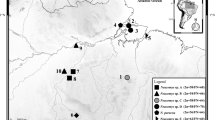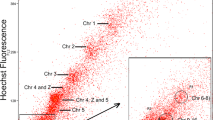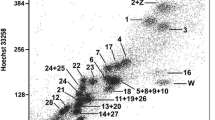Abstract
The order Perissodactyla, the group of odd-toed ungulates, includes three extant families: Equidae, Tapiridae, and Rhinocerotidae. The extremely rapid karyotypic diversification in perissodactyls has so far prevented the establishment of genome-wide homology maps between these three families by traditional cytogenetic approaches. Here we report the first genome-wide comparative chromosome maps of African rhinoceroses, four tapir species, four equine species, and humans. These maps were established by multidirectional chromosome painting, with paint probes derived from flow-sorted chromosomes of Equus grevyi, Tapirus indicus, and Ceratotherium simum as well as painting probes from horse and human. The Malayan tapir (Tapirus indicus), Baird’s tapir (T. bairdii), mountain tapir (T. pinchaque), lowland tapir (T. terrestris), and onager (E. hemionus onager), were studied by cross-species chromosome painting for the first time. Our results, when integrated with previously published comparative chromosome maps of the other perissodactyl species, have enabled the reconstruction of perissodactyl, ceratomorph, and equid ancestral karyotypes, and the identification of the defining evolutionary chromosomal rearrangements along each lineage. Our results allow a more reliable estimate of the mode and tempo of evolutionary chromosomal rearrangements, revealing a striking switch between the slowly evolving ceratomorphs and extremely rapidly evolving equids.
Similar content being viewed by others
References
Balmus G, Trifonov VA, Biltueva LS et al. (2007) Cross species painting among camel, cattle, pig and human: further insights into the putative Cetartiodactyla ancestral karyotype. Chromosome Res 15: 499–514.
Benirschke K, Brownhill LE, Beath MM (1962) Somatic chromosomes of the horse, the donkey and their hybrids, the mule and the hinny. J Reprod Fertil 4: 319.
Benirschke K, Malouf N, Low RJ, Heck H (1965) Chromosome complement differences between Equus caballus and Equus przewalskii, Poliakoff. Science 148: 382.
Benirschke K, Malouf N (1967) Chromosome studies of Equidae. Equus 1: 253–284.
Bielec PE, Gallagher DS, Womack JE, Busbee DL (1998) Homologies between human and dolphin chromosomes detected by heterologous chromosome painting. Cytogenet Cell Genet 81: 18–26.
Biltueva LS, Yang F, Vorobieva NV, Graphodatsky AS (2004) Comparative map between the domestic pig and dog. Mamm Genome 15: 809–818.
Bowling AT, Ruvinsky A, eds (2000) The Genetics of the Horse. Wallingford, UK: CAB International.
Bradley R, Wichman HA (1994) Rapidly evolving repetitive DNA in a conservative genome: a test of factors that affect chromosomal evolution. Chromosome Res 2: 354–360.
Bush GL, Case SM, Wilson AC, Patton JL (1977) Rapid speciation and chromosomal evolution in mammals. Proc Natl Acad Sci USA 74: 3942–3946.
Caetano AR, Shiue Y, Lyons LA et al. (1999) A comparative gene map of the horse (Equus caballus). Genome Res 9: 1239–1249.
Carbone L, Nergadze SG, Magnani E et al. (2006) Evolutionary movement of centromeres in horse, donkey, and zebra. Genomics 87: 777–782.
Chowdhary BP, Raudsepp T, Kata SR et al. (2003) The first-generation whole-genome radiation hybrid map in the horse identifies conserved segments in human and mouse genomes. Genome Res 13: 742–751.
Dobigny G, Ducroz JF, Robinson TJ, Volobouev V (2004) Cytogenetics and cladistics. Syst Biol 53: 470–484.
Dobigny G, Aniskin V, Granjon L, Cornette R, Volobouev V (2005) Recent radiation in West African Taterillus (Rodentia, Gerbillinae): the concerted role of chromosome and climatic changes. Heredity 95: 358–368.
Graphodatsky A, Radjabli S (1988) GTG- and C-banded chromosomes of horse and donkey. In: Baranov OK, ed. Chromosomes of Agricultural and Laboratory Mammals. Novosibirsk: “Nauka”.
Graphodatsky AS, Yang F, O’Brien PC et al. (2000) A comparative chromosome map of the Arctic fox, red fox and dog defined by chromosome painting and high resolution G-banding. Chromosome Res 8: 253–263.
Guérin G, Bailey E, Bernoco D et al. (1999) Report of the International Equine Gene Mapping Workshop: male linkage map. Anim Genet 30: 341–354.
Guérin G, Bailey E, Bernoco D et al. (2003) The second generation of the International Equine Gene Mapping Workshop half-sibling linkage map. Anim Genet 34: 161–168.
Houck ML, Ryder OA, Vahala J, Kock RA, Oosterhuis JE (1994) Diploid chromosome number and chromosomal variation in the White rhinoceros (Ceratotherium simum). J Hered 85: 30–34.
Houck ML, Ryder OA, Kumamoto AT, Benirschke K (1995) Cytogenetics of the Rhinocerotidae. Sonderdruck aus Verhandlumgsbericht des 37. Internationalen Symp. uber die Erkrankungen der Zootiere, Dresden, pp. 25–32.
Houck ML, Kumamoto AT, Cabrera RM, Benirschke K (1998) Chromosomal rearrangements in a Somali wild ass pedigree, Equus africanus somaliensis (Perissodactyla, Equidae). Cytogenet Cell Genet 80: 117–122.
Houck ML, Kingswood SC, Kumamoto AT (2000) Comparative cytogenetics of tapirs, genus Tapirus (Perissodactyla, Tapiridae). Cytogenet Cell Genet 89: 110–115.
Itoh T, Watanabe T, Ihara N et al. (2005) A comprehensive radiation hybrid map of the bovine genome comprising 5593 loci. Genomics 85: 413–424.
Koehler U, Bigoni F, Wienberg J, Stanyon R (1995) Genomic reorganization in the concolor gibbon (Hylobates concolor) revealed by chromosome painting. Genomics 30: 287–292.
Lindsay EH, Opdyke ND, Johnson NM (1980) Pliocene dispersal of the horse Equus and late Cenozoic mammal dispersal events. Nature 287: 135–138.
Milenkovic D, Oustry-Vaiman A, Lear TL et al. (2002) Cytogenetic localization of 136 genes in the horse: comparative mapping with the human genome. Mamm Genome 13: 524–534.
Mueller S, Hollatz M, Wienberg J (2003) Chromosomal phylogeny and evolution of gibbons (Hylobatidae). Hum Genet 113: 493–501.
Murphy WJ, Larkin DM, Everts-van der Wind A et al. (2005) Dynamics of mammalian chromosome evolution inferred from multispecies comparative maps. Science 309: 613–617.
Murphy WJ, Pringle TH, Tess A, Crider TA, Springer MS, Miller W (2007a) Using genomic data to unravel the root of the placental mammal phylogeny. Genome Res 17: 413–421.
Murphy WJ, Davis B, David VA et al. (2007b) A 1.5-Mb-resolution radiation hybrid map of the cat genome and comparative analysis with the canine and human genomes. Genomics 89: 189–196.
Musilova P, Kubikova S, Zrnova E et al. (2007) Karyotypic relationships among Equus grevyi, Equus burchelli and domestic horse defined using horse chromosome arm-specific probes. Chromosome Res 15: 807–813.
Myka JL, Lear TL, Houck ML, Ryder OA, Bailey E (2003) Homologous fission event(s) implicated for chromosomal polymorphisms among five species in the genus Equus. Cytogenet Genome Res 102: 217–221.
Norman JE, Ashley MV (2000) Phylogenetics of Perissodactyla and tests of the molecular clock. J Mol Evol 50: 11–21.
Oakenfull EA, Clegg JB (1998) Phylogenetic relationships within the genus Equus and the evolution of α and θ globin genes. J Mol Evol 47: 772–783.
Oakenfull EA, Lim HN, Ryder OA (2000) A survey of equid mitochondrial DNA: implications for the evolution, genetic diversity and conservation of equids. Conservation Genetics 1: 341–355.
O’Brien SJ, Menninger JC, Nash WG (2006) Equus hemionus onager (onager). In: O' Brien SJ, Menninger JC, Nash WG, eds. Atlas of Mammalian Chromosomes. New York: Wiley-Liss.
Padro Manuel de Villena F, Sapienza C (2001) Female meiosis drives karyotypic evolution in mammals. Genetics 159: 1179–1189.
Penedo MCT, Millon LV, Bernoco D et al. (2005) International equine gene mapping workshop report: a comprehensive linkage map constructed with data from new markers and by merging four mapping resources. Cytogenet Genome Res 111: 5–15.
Pitra C, Veits J (2000) Use of mitochondrial DNA sequences to test the Ceratomorpha (Perissodactyla: Mammalia) hypothesis. J Zool Syst Evol Res 38: 65–72.
Prothero DR, Schoch RM, eds (1989) The Evolution of Perissodactyls. New York: Oxford University Press.
Raudsepp T, Chowdhary BP (1999) Construction of chromosome specific paints for meta and sub-metacentric autosomes and the sex chromosomes in the horse and their use to detect homologous chromosomal segments in the donkey. Chromosome Res 6: 103–114.
Raudsepp T, Frönicke L, Scherthan H, Gustavsson I, Chowdhary BP (1996) Zoo-FISH delineates conserved chromosomal segments in horse and man. Chromosome Res 4: 1–8.
Raudsepp T, Kijas J, Godard S et al. (1999) Comparison of horse chromosome 3 with donkey and human chromosomes by cross-species painting and heterologous FISH mapping. Mamm Genome 10: 211–282.
Raudsepp T, Christensen K, Chowdhary BP (2000) Cytogenetics of donkey chromosomes: nomenclature proposal based on GTG-banded chromosomes and depiction of NORs and telomeric sites. Chromosome Res 8: 659–670.
Raudsepp T, Mariat D, Guerin G, Chowdhary BP (2001) Comparative FISH mapping of 32 loci reveals new homologous regions between donkey and horse karyotypes. Cytogenet Cell Genet 94: 180–185.
Richard F, Messaoudi C, Lombard M, Dutrillaux B (2001) Chromosome homologies between man and mountain zebra (Equus zebra hartmannae) and description of a new ancestral synteny involving sequences homologous to human chromosomes 4 and 8. Cytogenet Cell Genet 93: 291–296.
Robinson TJ, Seiffert E (2004) Afrotherian origins and interrelationships: new views and future prospects. Curr Top Dev Biol 63: 37–60.
Robinson TJ, Trifonov V, Espie I, Harley EH (2005) Interspecific hybridisation in rhinoceroses: Confirmation of a Black × White rhinoceros hybrid by karyotype, fluorescence in situ hybridisation (FISH) and microsatellite analysis. Conservation Genetics 6: 141–145.
Ryder OA (1978) Chromosomal polymorphism in Equus hemionus. Cytogenet Cell Genet 21: 177–183.
Ryder OA, Epel NC, Benirschke K (1978) Chromosome banding studies of the Equidae. Cytogenet Cell Genet 20: 323–350.
Seabright M (1971) A rapid banding technique for human chromosomes. Lancet 2: 971–972.
Scherthan H, Cremer T, Arnason U, Weier HU, Lima-de-Faria A, Froenicke L (1994) Comparative chromosome painting discloses homologous segments in distantly related mammals. Nat Genet 6: 342–347.
Swofford DL (1997) PAUP*: Phylogenetic analysis using parsimony, beta test version 4.0. Sunderland, MA: Sinauer.
Telenius H, Pelmear AH, Tunnacliffe A et al. (1992) Cytogenetic analysis by chromosome painting using DOP-PCR amplified flow-sorted chromosomes. Genes Chromosomes Cancer 4: 257–263.
Tougard C, Delefosse T, Hänni C, Montgelard C (2001) Phylogenetic relationships of the five extant rhinoceros species (Rhinocerotidae, Perissodactyla) based on mitochondrial cytochrome b and 12S rRNA genes. Mol Phylogenet Evol 19: 34–44.
Trifonov V, Yang F, Ferguson-Smith MA, Robinson TJ (2003) Cross-species chromosome painting in the Perissodactyla: delimitation of homologous regions in Burchell’s Zebra (Equus burchellii) and the White (Ceratotherium simum) and Black Rhinoceros (Diceros bicornis). Cytogenet Genome Res 103: 104–110.
Trommershausen-Bowling A, Millon L (1988) Centric fission in the karyotype of mother–daughter pair of donkeys (Equus asinus). Cytogenet Cell Genet 47: 152–154.
Wang W, Lan H (2000) Rapid and parallel chromosomal number reductions in muntjac deer inferred from mitochondrial DNA phylogeny. Mol Biol Evol 17: 1326–1333.
Whitehouse DB, Evans EP, Putt W, George AM (1984) Karyotypes of the East African common zebra, Equus burchelli: centric fission in a pedigree. Cytogenet Cell Genet 38: 171–175.
Wood HE (1937) Perissodactyl suborders. J Mammal 18: 106.
Wurster DH, Benirschke K (1968) The chromosomes of the Great Indian rhinoceros. Experimentia 24: 511.
Xu X, Janke A, Arnason U (1996) The complete mitochondrial DNA sequence of the greater Indian rhinoceros, Rhinoceros unicornis, and the phylogenetic relationship among Carnivora, Perissodactyla, and Artiodactyla (plus Cetacea). Mol Biol Evol 13: 1167–1173.
Yang F, Carter NP, Shi L, Ferguson-Smith MA (1995) A comparative study of karyotypes of muntjacs by chromosome painting. Chromosoma 103: 642–652.
Yang F, O’Brien PC, Milne BS et al. (1999) A complete comparative chromosome map for the dog, red fox, and human and its integration with canine genetic maps. Genomics 62: 189–202.
Yang F, Graphodatsky AS, O’Brien PC et al. (2000) Reciprocal chromosome painting illuminates the history of genome evolution of the domestic cat, dog and human. Chromosome Res 8: 393–404.
Yang F, Fu B, O’Brien PC, Robinson TJ, Ryder OA, Ferguson-Smith MA (2003) Karyotypic relationships of horses and zebras: results of cross-species chromosome painting. Cytogenet Genome Res 102: 235–243.
Yang F, Fu B, O’Brien PC, Nie W, Ryder OA, Ferguson-Smith MA (2004) Refined genome-wide comparative map of the domestic horse, donkey and human based on cross-species chromosome painting: insight into the occasional fertility of mules. Chromosome Res 12: 65–76.
Yang F, Graphodatsky AS, Li T et al. (2006) Comparative genome maps of the pangolin, hedgehog, sloth, anteater and human revealed by cross-species chromosome painting: further insight into the ancestral karyotype and genome evolution of eutherian mammals. Chromosome Res 14: 283–286.
Author information
Authors and Affiliations
Corresponding authors
Electronic Supplementary Material
Below is the link to the electronic supplementary material.
Supplementary Table S1
Matrix of human-based (HSA) and horse-based (ECA) chromosomal characters. EPR, EHE, EAS, EZE, EGR, EBU, CSI, DBI, TIN, TBA, TTE, TPI represent Przewalski’s horse, onager, donkey, mountain zebra, Grevy’s zebra, Burchell’s zebra, white rhinoceros, black rhinoceros, Malayan tapir, Baird’s tapir, lowland tapir, and mountain tapir respectively. Partial chromosomes/chromosome arms are marked by inverted commas. “Inv” indicates inversion (DOC 154 kb)
Supplementary Figure S2
Karyotype of Grevy’s zebra with human (HSA) and Malayan tapir (TIN) homologies. Human homologies that were not found in these experiments, but are inferred from previously published data are indicated by circles (JPEG 214 kb)
Rights and permissions
About this article
Cite this article
Trifonov, V.A., Stanyon, R., Nesterenko, A.I. et al. Multidirectional cross-species painting illuminates the history of karyotypic evolution in Perissodactyla. Chromosome Res 16, 89–107 (2008). https://doi.org/10.1007/s10577-007-1201-7
Published:
Issue Date:
DOI: https://doi.org/10.1007/s10577-007-1201-7




